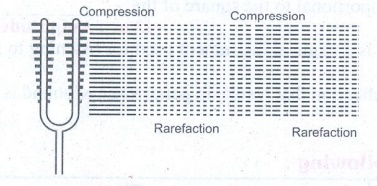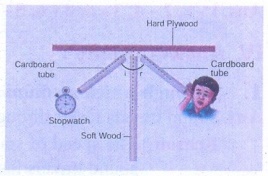Sound | Physics | Science - Answer the following questions | 9th Science : Physics : Sound
Chapter: 9th Science : Physics : Sound
Answer the following questions
SOUND
TEXT BOOK EXERCISES
IV. Answer briefly:
1. Through which medium sound
travels faster, iron or water? Give reason.
Answer: Sound
travels faster through iron than water.
Reason: The speed
of sound depends on the nature of medium. As Iron is a solid, sound travels
faster through iron than Water.
2. Name the physical quantity
whose SI unit is ‘hertz’. Define.
Answer: The SI
unit of Frequency is Hertz. Frequency is
the number of waves produced in one second.
3. What is meant by supersonic
speed?
Answer:
Supersonic speed is the speed of an object that exceeds the speed of sound in
air (330 ms-1).
4. How does the sound produced by
a vibrating object in a medium reach your ears?
Answer: 1.When
an object vibrates, it sets the particles of the medium around it vibrating.
2.
The vibrating particles in the medium displace from the equilibrium position
and exerts pressure on adjacent particles.
3.
Thus this process continues in the medium till the sound reaches our ear.
5. You and your friend are on the
moon. Will you be able to hear any sound produced by your friend?
Answer: We cannot
hear any sound on the moon.
Reason: Absence
of atmosphere (medium) in the moon.
V. Answer in detail:
1. Describe with diagram, how
compressions and rarefactions are produced.
Answer:
Compressions:
When
a vibrating body moves forward, it creates a region of high pressure is known
as compressions. In compression, the particles are more densed. Compressions
are the region where particles are crowded together.

Rarefaction:
When
the vibrating body moves backward, it creates a region of low pressure (i.e)
low density of particles. This is called rarefaction. Rarefactions are the
regions where particles are spread apart.
2. Verify experimentally the laws
reflection of sound.
Answer:
1.
Make two identical long pipes using chart paper.
2.
Arrange them on a table near wall.
3.
Keep a clock near the open end of one pipe and hear the sound of the clock
through the other pipe.

4.
Adjust the pipe till the sound of the clock heard with more clarity.
5.
Now measure the angle of incidence and reflection and see the relationship
between the angles.
6.
The angle in which the sound is incident is equal to the angle in which sound
is reflected.
7.
Direction of incident sound, direction of the reflected and the normal are in
the same plane.
8. Thus laws of reflection of sound are verified.
3. List the applications of
sound.
Answer:
Applications of
Ultrasonic Sound
1. Cleaning
Technology:
Minute
foreign particles can be removed from objects placed in a liquid bath by
ultrasonic sound waves.
2. Industry:
To
detect cracks and flaws in metal blocks
3. Medicine
(i) Echo
cardiography:
Ultrasonic
waves are made to reflect from various parts of the heart and form the image of
the heart.
(ii) In Kidney:
To
break small stones formed in the kidney into fine grains, which is flushed out
with urine.
4. Explain how does SONAR work.
Answer:
SONAR is the abbreviation for Sound Navigation And Ranging.
(i) SONAR
consists of a transmitter and a detector and they are installed at the bottom
of boats and ships.
(ii)
The
Transmitter produces and transmits the ultrasonic waves to travel
through water.
(iii)
The detector
senses the ultrasonic waves that reflected back after striking the object.
(iv)
It converts ultrasonic waves into electrical signals which can be interpreted.
(v)
By knowing the speed of sound in water (v)
and time interval (t) between transmission
and reception of ultrasonic sound, the distance of the object can be calculated
by, 2d = v × t
(vi)
This method is called echo-ranging.
VI. Numerical problems:
1. The frequency of a source of
sound is 600 Hz. Calculate the number of times it vibrates in a minute?
Solution:
Given:
Frequency,
v = 600 Hz.
Frequency
= Number of vibrations in a second.
Frequency
in a minute = Frequency per second × 60
= 600 Hz × 60
No.
of vibrations in a minute = 36,000 Hz (or) 36
kHz.
2. A stone is dropped from the top
of a tower 750 m high into a pond of water at the base of the tower. Calculate
the number of seconds for the splash to be heard? (Given g = 10 m s-2
and speed of sound = 340 m s-1)
Solution:
Given:
Height
of tower, s = 750 m
Acceleration,
g =10 ms-2
Speed
of sound, v = 340 ms-1
Initial
velocity of stone, u =0 (stone at
rest)
Consider
(i)
Time taken to reach the pond, t1.
(ii)
Time taken by sound to reach top, t2
According
to Equation of Motion, s = ut + (1/2)at2
Here, s = ut1 + (1/2) gt12
Substituting the values. 750 = 0 × t1
+(1/2) × 10 × t12
750= 5t12
t12 =150
t1
= 12.25 s
Time
taken by sound to reach top t2 = (s/v) = (750 /340) =2.2 s
t2 = 2.2s
Time
for splash to be heard at top, t = t1 +t2
t = 12.25 + 2.2
t = 14.45s
Time
for splash to be heard at top, t =
14.45s.
Intext Activities
ACTIVITY - 1
Take a tuning fork and strike its
prongs on a rubber pad. Bring it near your ear. Do you hear any sound? Now
touch the tuning fork with your finger. What do you feel? Do you feel
vibrations?
Aim: To demonstrate
the vibration of a molecule.
Materials Required: 1. Tuning fork, 2. Rubber band.
Procedure:
1
.Take a tuning fork and strike its prongs on a rubber pad.
2.
Bring it near your ear. Hear the sound.
3.
Touch the tuning fork with finger.
4.
Try to feel the vibrations.
Observation:
When
we strike the tuning fork on the rubber pad, it starts vibrating. The
vibrations can be felt.
Conclusion:
Tuning
fork vibrates the molecules which will vibrate the nearby molecules.
[Vibration
= movement of molecule from mean position].
ACTIVITY - 2
Take a coil or spring and move it
forward and backward. What do you observe? You can observe that in some parts
of the coil the turns will be closer and in some other parts the turns will be
far apart. Sound also travels in a medium in the same manner. We will study
about this now.

Aim: To
demonstrate the propagation of Longitudinal wave. (Sound)
Materials required: 1. Coil,
2.Spring
Procedure:
1.
Take a coil or spring
2.
Move it forward and backward.
Observations:
1.
Some parts of the coil, the turns are closer.
2.
In other parts, the turns are far apart.
Conclusion:
1.
Closer turns represent compressions.
2.
Far apart turns are rarefactions.
3.
Longitudinal waves propagate through compressions and rarefactions.
ACTIVITY - 3
Listen to the audio of any
muscial instruments like flute,
nathaswaram, tabla, drums, veena etc., Tabulate the differences between the
sounds produced by the various sources.
Aim: To compare the sounds of musical instruments.
Materials required: 1.
Flute, 2. Drums, 3. Veena,
Procedure:
1.
Hear the instrumental music of flute, drums and veena.
2.
Tabulate the difference between the sounds.
Observation:

Conclusion:
Sounds
in the different music instruments are characterised by the following qualities
such as.
1.
Amplitude,
2.
Wavelength,
3.
Frequency,
4.
Pitch,
5.
Loudness.
Related Topics